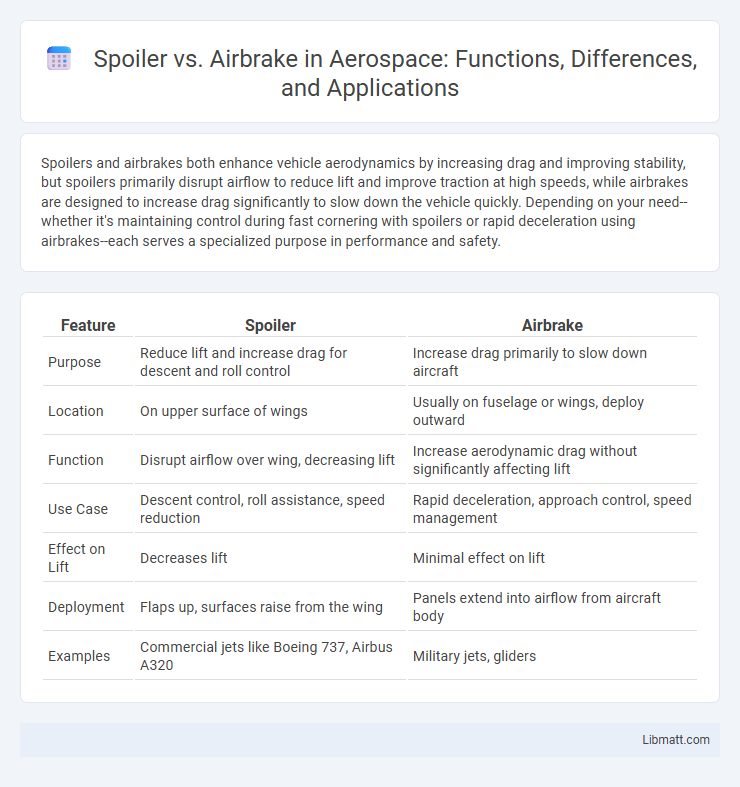Spoilers and airbrakes both enhance vehicle aerodynamics by increasing drag and improving stability, but spoilers primarily disrupt airflow to reduce lift and improve traction at high speeds, while airbrakes are designed to increase drag significantly to slow down the vehicle quickly. Depending on your need--whether it's maintaining control during fast cornering with spoilers or rapid deceleration using airbrakes--each serves a specialized purpose in performance and safety.
Table of Comparison
| Feature | Spoiler | Airbrake |
|---|---|---|
| Purpose | Reduce lift and increase drag for descent and roll control | Increase drag primarily to slow down aircraft |
| Location | On upper surface of wings | Usually on fuselage or wings, deploy outward |
| Function | Disrupt airflow over wing, decreasing lift | Increase aerodynamic drag without significantly affecting lift |
| Use Case | Descent control, roll assistance, speed reduction | Rapid deceleration, approach control, speed management |
| Effect on Lift | Decreases lift | Minimal effect on lift |
| Deployment | Flaps up, surfaces raise from the wing | Panels extend into airflow from aircraft body |
| Examples | Commercial jets like Boeing 737, Airbus A320 | Military jets, gliders |
Understanding Spoilers and Airbrakes: Key Differences
Spoilers and airbrakes both modify airflow to influence vehicle or aircraft performance but serve distinct purposes: spoilers reduce lift and increase drag primarily to improve stability and control, while airbrakes are designed specifically to increase drag for rapid deceleration. Spoilers disrupt airflow over wings or vehicle surfaces, reducing lift and enhancing downforce in automotive applications, whereas airbrakes deploy as panels or surfaces that project into the airflow to maximize drag without significantly affecting lift. Understanding these functional differences is essential in optimizing aerodynamic designs for braking efficiency and stability control in both automotive and aerospace engineering.
The Purpose of Spoilers in Aircraft Design
Spoilers in aircraft design primarily serve to disrupt airflow over the wings, reducing lift and increasing drag to slow the aircraft during descent and landing. Unlike airbrakes, which are designed solely to increase drag without affecting lift, spoilers provide precise control over lift reduction for safer and more efficient deceleration. Your understanding of spoilers highlights their critical role in enhancing an aircraft's stability and control during critical flight phases.
Airbrakes Explained: Function and Benefits
Airbrakes are aerodynamic devices designed to increase drag and reduce speed by disrupting airflow over a vehicle or aircraft surface. By deploying airbrakes, pilots or drivers can achieve better control during descent or deceleration phases without sacrificing lift or stability. Unlike spoilers, which primarily reduce lift, airbrakes focus on maximizing drag, making them essential for precise speed management and improved safety.
How Spoilers Work: Mechanisms and Applications
Spoilers function by disrupting airflow over a vehicle's surface, reducing lift and increasing downforce to improve traction and stability at high speeds. These aerodynamics devices deploy by raising panels on the vehicle's rear or wings, creating turbulence that slows airflow and enhances braking efficiency. Widely used in high-performance cars and aircraft, spoilers optimize control during cornering and descent phases by manipulating aerodynamic forces.
The Role of Airbrakes in Deceleration and Safety
Airbrakes play a crucial role in deceleration by increasing aerodynamic drag, allowing aircraft to reduce speed rapidly during descent or landing. Unlike spoilers, which primarily disrupt lift, airbrakes are designed specifically to slow the aircraft efficiently without compromising control. Understanding how airbrakes enhance safety through controlled speed reduction helps optimize your flight performance and ensures effective braking under various conditions.
Spoilers vs. Airbrakes: Structural and Operational Comparison
Spoilers and airbrakes both serve to increase drag and reduce lift on an aircraft, but their structural designs and operational uses differ significantly. Spoilers, typically flat panels hinged on the upper wing surface, disrupt airflow to decrease lift and assist with roll control, primarily during descent and landing. Airbrakes are larger surfaces that extend into the airflow, focused exclusively on increasing drag to slow the aircraft without significantly affecting lift, improving your ability to control speed during flight transitions.
Impact on Flight Performance: Spoilers vs. Airbrakes
Spoilers reduce lift by disrupting airflow over the wing, enabling rapid descent and increased drag, which enhances roll control and landing precision. Airbrakes primarily increase drag without significantly affecting lift, allowing for controlled deceleration during flight without altering the aircraft's lift characteristics. The distinct aerodynamic roles of spoilers and airbrakes directly influence flight performance, with spoilers optimizing lift modulation and airbrakes maximizing drag for speed regulation.
Common Misconceptions about Spoilers and Airbrakes
Many people mistakenly believe spoilers and airbrakes serve the same purpose, but spoilers primarily disrupt airflow to reduce lift and increase downforce, enhancing vehicle stability. Airbrakes focus on creating drag to slow down the vehicle efficiently, especially at high speeds. Understanding the distinct roles of these aerodynamic devices can help you optimize your driving performance and vehicle control.
Selecting the Right Device: Factors for Engineers and Pilots
Engineers and pilots must consider aerodynamic efficiency, control precision, and aircraft type when selecting between spoilers and airbrakes. Spoilers primarily reduce lift and assist in roll control, making them ideal for handling descent rates and lateral stability, while airbrakes increase drag without significantly affecting lift, optimizing speed reduction. Your decision should balance these factors to enhance safety, performance, and maneuverability during various flight phases.
Future Trends in Spoiler and Airbrake Technology
Future trends in spoiler and airbrake technology emphasize enhanced aerodynamic efficiency through adaptive materials and real-time control systems, improving vehicle stability at high speeds. Integration of smart sensors and AI allows precise modulation of airflow, optimizing performance and fuel efficiency in various driving conditions. You can expect these advancements to become standard in next-generation sports and commercial vehicles, delivering superior handling and safety.
spoiler vs airbrake Infographic

 libmatt.com
libmatt.com